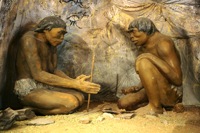Caveman
Definitions
Description
A caveman or troglodyte is a stock character based upon widespread concepts of the way in which early prehistoric humans may have looked and behaved. The term caveman, sometimes used colloquially to refer to Neanderthal people, originates out of assumptions about the association between early humans and caves, most clearly demonstrated in cave painting or bench models.
Cavemen are frequently represented as living with dinosaurs in popular culture, despite the fact dinosaurs became extinct at the end of the Cretaceous period, some 65 million years before the emergence of the human species. One of the earliest portrayals of cavemen and dinosaurs together is D. W. Griffith's Brute Force, a silent film released in 1914, while more recent examples include the comic strip B.C. and the television series The Flintstones.
Caveman-like heraldic "wild men" were found in European and African iconography for hundreds of years. During the Middle Ages, these creatures were generally depicted in art and literature as bearded and covered in hair, and often wielding clubs and dwelling in caves. While wild men were always depicted as living outside of civilization, there was an ongoing debate as to whether they were human or animal.
Cavemen are portrayed as wearing shaggy animal hides, armed with rocks or cattle bone clubs, unintelligent, and aggressive. The image of them living in caves arises from the fact that caves are where the preponderance of ritual paintings and artifacts from prehistoric cultures have been found, although this most likely reflects the degree of preservation that caves provide over the millennia rather than an indication of their typical form of shelter. Expressions such as "living in a cave" have become cultural metaphors for a modern human who displays traits of great ignorance or uncivilized behavior.[1]
See also
Quote
100:4.5 In the mind's eye conjure up a picture of one of your primitive ancestors of cave-dwelling times—a short, misshapen, filthy, snarling hulk of a man standing, legs spread, club upraised, breathing hate and animosity as he looks fiercely just ahead. Such a picture hardly depicts the divine dignity of man. But allow us to enlarge the picture. In front of this animated human crouches a saber-toothed tiger. Behind him, a woman and two children. Immediately you recognize that such a picture stands for the beginnings of much that is fine and noble in the human race, but the man is the same in both pictures. Only in the second sketch you are favored with a widened horizon. You therein discern the motivation of this evolving mortal. His attitude becomes praiseworthy because you understand him. If you could only fathom the motives of your associates, how much better you would understand them. If you could only know your fellows, you would eventually fall in love with them.
